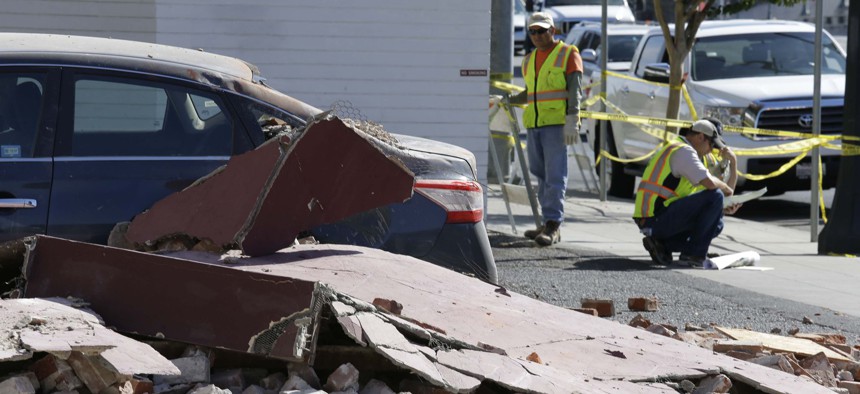Californians Deprioritize Need for Earthquake Retrofitting and Insurance

City workers at right map out the installation of fencing around earthquake damaged buildings Tuesday, Aug. 26, 2014, in Napa, Calif. Eric Risberg / AP File Photo
But a new study shows that there are ways state and local governments can change that.
Single-family homeowners in southern Napa County, California are generally aware of the seismic risks they face after a magnitude-6.0 earthquake shook their area in 2014, but that doesn’t mean they’re taking adequate steps to mitigate them.
A survey sponsored by the California Earthquake Authority, “South Napa Single-Family Home Impact Study,” found that many residents are unaware they can make seismic retrofits to their properties or that theirs hadn’t been modified.
Participants were often unaware of the earthquake insurance options available to them, and few sought out that information despite the seismic activity in the region.
One death was attributed to the August 2014 earthquake, and while significant damage was relatively limited, it still caused hundreds of millions in damage, particularly to older, unreinforced brick and masonry structures. Napa’s temblor was the most significant seismic event in the San Francisco Bay area since the magnitude 6.9 Loma Prieta quake in 1989 and highlighted just how unprepared the vast majority of Californians are when it comes to having earthquake insurance or seismic upgrades.
“What we saw in this study really reinforces the need for clear, consistent access to facts about retrofitting and insurance so that people can make informed decisions,” Janiele Maffei, CEA chief mitigation officer, said in a statement. “With the earthquake risks in California, it’s important that people know how to strengthen their older houses and protect themselves financially.”
Among respondents, 13 percent said they considered selling their home or relocating in the 2014 quake’s aftermath, even if their residence had been retrofitted. Only 24 percent sought information about strengthening their housing, according to the study, which hypothesized that most Californians, similarly, don’t think about such things.
Only one in 10 Napa households had earthquake upgrades performed before the 2014 quake, upgrades like anchoring, chimney removal and bolstering the basement—the most common ones. More than one fourth of participants, 29 percent, skipped the survey question on retrofitting or did not know their home’s status.
About 10 percent of respondents said they had earthquake insurance prior to the 2014 quake, and most wrongly thought deductible levels were fixed at 10 percent and didn’t know renter’s or contents coverage were also available. Of the 51 respondents that submitted an insurance claim, few received a payout, according to the study.
Worth noting is the fact the survey was not a random sample of participants, and therefore results could be skewed by residents with issues wanting to tell their stories more readily.
Moving forward, when it comes to providing better preparedness and mitigation information, most interviewees said they looked to their government’s website and building department, according to the study:
Some interviewees expressed a desire for mandates or a stronger role of government in leading the way in community earthquake mitigation. Higher standards should be built into the building code, especially for new construction. Cities should keep the pressure on; they could query property record based on year built and mail them a notice. Cities should have an ombudsman to guide people in making decisions and navigating paperwork of doing retrofit work. People need help with zoning issues and how to address their house’s situation. “The onus of improving homes should not be left to the homeowner alone, builders should be included.”
Home inspectors felt homeowners would not be interested in their earthquake risk assessment without “clear and substantial” advantages, as other government programs like free energy audits are already underutilized.
CEA intends to launch its own program with grants for research projects.
“Research efforts can inform future engineering practices and disaster policies in a variety of ways,” Maffei said. “Ultimately, the more information we all have, the more we can be prepared before the ground starts shaking.”
The full report can be read here.
Dave Nyczepir is a News Editor with Government Executive’s Route Fifty and is based in Washington, D.C.
NEXT STORY: The Reasons Why Americans Aren't Moving as Much These Days






